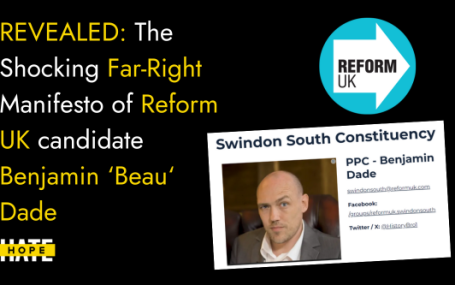HOPE not hate uses cookies to collect information and give you a more personalised experience on our site. You can find more information in our privacy policy. To agree to this, please click accept.
“My German great-grandmother is 96-years-old. She was born right after the First World War and lived through Second World War, and it is striking how she perceives today’s world as similar to what she experienced before the war.”
Julia Ebner says hearing her great-grandmother speak of her experiences changed her perception of the present. The young researcher, who wrote her masters thesis on female suicide bombers, says the 2015 terrorist attacks in Paris solidified her determination to work on extremism prevention.
“But the more research I did, the more I realised there were forms of extremism that weren’t addressed as much as Islamist extremism. I realised there was a symbiotic relationship, with different extremist groups driving each other into becoming more extreme, fuelling each other’s rhetoric,” she says.
This concept of cumulative extremism – described by leading academic Roger Eatwell in 2006 as the way one form of extremism can feed off and magnify other forms of extremism – has been gaining traction in academic circles.
Ebner’s research led her to interview homeless people, refugees, hackers, intelligence officers, former jihadist and far-right militants. She was surprised by how welcome she was made to feel when she went undercover at an anti-Muslim English Defence League (EDL) rally and later at an event for the pan-Islamist international movement, Hizb ut-Tahrir.
“It was hard to distance myself, even with what they said. I can understand how you could quickly get involved with either – everyone was so nice,” she says.
Researching the subject and finding interviews wasn’t always easy.
“I had my avatar Twitter accounts shut down countless times, got held up in security checks for carrying inflammatory literature and internal teaching materials of extremist groups with me, and spent the US elections night monitoring the social media feed of extremists,” she writes in the book of her experiences, The Rage.
She found that the socio-economic and physical fears of both far-right and Islamist extremists remained very similar and tied to an overarching victimhood narrative.
“On both sides, there’s perceived humiliation and both often mention their women being taken away by the opposite side,” Ebner explains. “Similar fears have been translated into anger and that rage is fostered by identity politics and by sensationalist reporting.”
Both the far-right and Islamist extremists hold to a narrative of a dystopian future, Day X, marking the breakdown of the system, she contends. For the far right, a race war will lead to a world free from any minorities.
Sometimes the two extremes converge. Claude Hermant, supporter of the Front National, France’s far-right party, was arrested for supplying the weapon used by Islamist extremist Amedi Coulibaly in his attack on a Jewish supermarket in 2015.
However, academics such as Graham Macklin, assistant professor at the Center for Research on Extremism at the University of Oslo in Norway, and Joel Busher, research fellow at the Centre for Trust, Peace and Social Relations at Coventry University in the UK, caution against simplifying cumulative extremism as “tit-for-tat” violence.
Macklin and Busher write that the strategic aims of activist groups, the dynamics of leadership and control, the actions and interactions of activists with state actors and emerging movement cultures and identities all shape how cumulative extremism develops.
“If we do not analyse and theorise why these interactions sometimes do not escalate towards violence and sometimes do not lead to greater societal polarization, it is likely that [cumulative extremism] will become a rather blunt analytical instrument that renders too many false positives—i.e. it will make spirals of violence and community polarization seem almost inevitable,” they state.
“You can’t fight one form of extremism without fighting the other because of narrative interaction between the two. They tell similar stories, just from different perspectives,” says Ebner.

Social media platforms are under increasing pressure from governments to prevent radicalisation and have been working hard to delete extremist accounts. However, Ebner says closing accounts is not enough to stop the cultural war happening online.
“Especially within the alt right, there is this new dimension to be cool and hip, hijacking many symbols, references, memes and movies. It’s often very funny and that’s what makes it so dangerous. Meanwhile, ISIS has revolutionised propaganda by referencing Hollywood movies and video games. It appeals to young people in a very dangerous way.”
Ebner admits it is too late to ignore their propaganda at this stage and that there needed to be “a really credible alternative message and narrative online.”
Civil societies rather than the government should mobilise everyone outside the two extremes by offering different solutions to their personal grievances.
Ebner adds that teaching children critical thinking, to question narratives and tell apart facts from fiction was the most important aspect in breaking the circle of rage.

A Reform Party candidate fantasised about deporting “millions” of British citizens to “rid itself of the foreign plague we have been diseased with”. UPDATE: Reform…